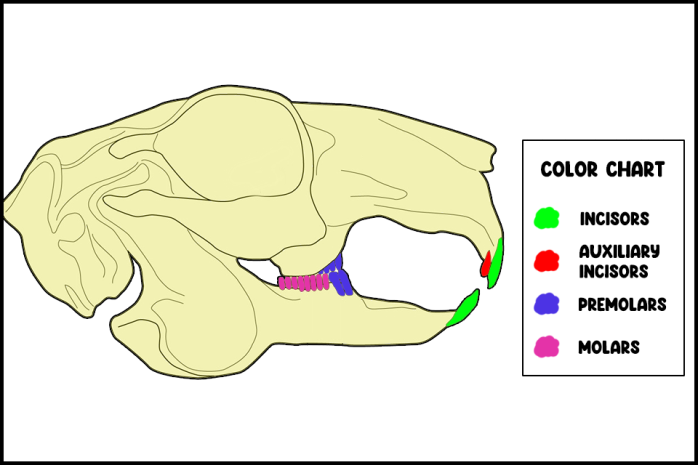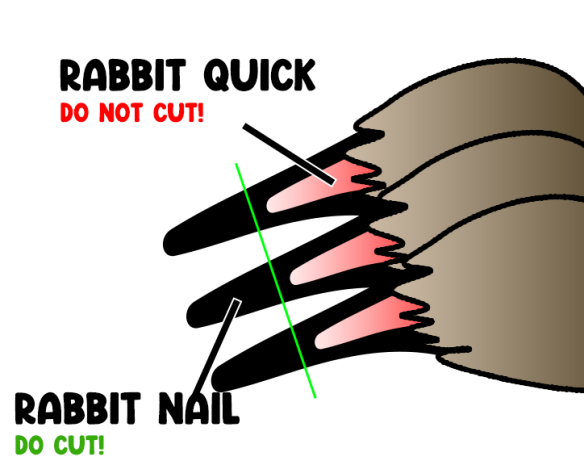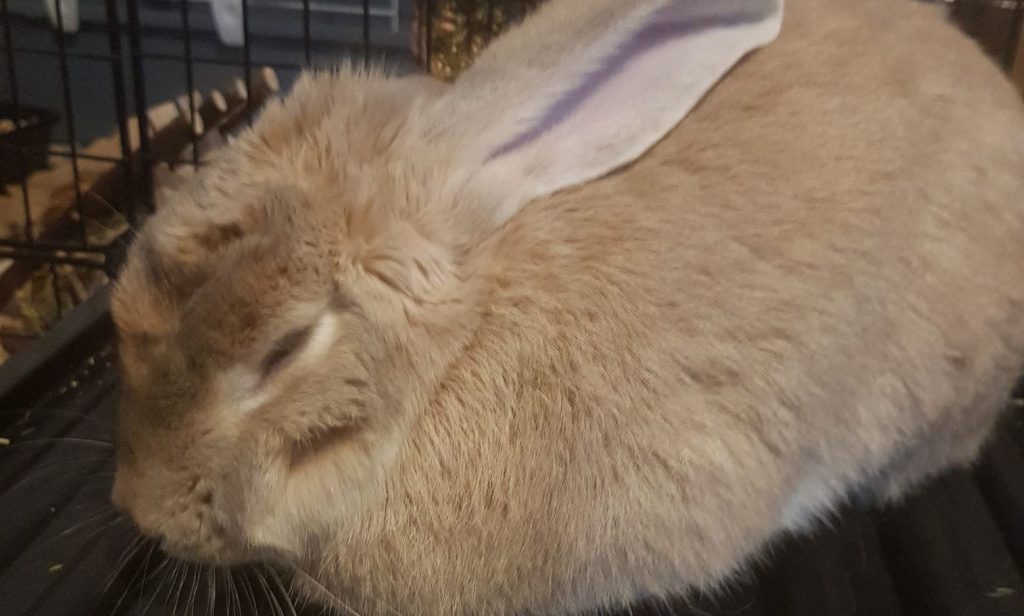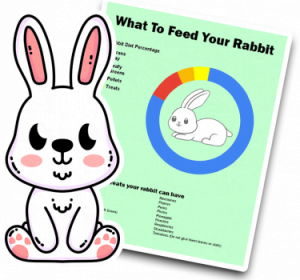
Domestic Rabbits groom themselves all the time. It can be removing fur, cleaning their behind, or even washing their ears. But sadly, they cannot groom every part of themselves effectively and will need assistance brushing, trimming their nails, and sometimes cleaning their bums to help them as they get older.
Rabbits make great pets, but they require proper grooming and hygiene to stay healthy and happy. Regular grooming and hygiene practices keep your rabbit looking clean and healthy and prevent illnesses and infections.
In this article, we will discuss the importance of grooming and hygiene for your pet rabbit and provide tips on how to maintain your rabbit’s grooming and hygiene routine.

This is Chapter 4 of The Beginner’s Guide to Rabbit Care
Grooming and hygiene are crucial for the health and well-being of rabbits. Rabbits are naturally clean animals, and maintaining their grooming and hygiene needs is essential to prevent health problems and ensure they live happy and comfortable lives.

When rabbits groom themselves, they often ingest their fur, which can accumulate in their stomachs and cause hairballs.
These hairballs can lead to blockages in the digestive tract, which can be painful and even life-threatening.
Regular grooming helps to remove any loose fur that may be ingested and prevents the accumulation of fur in the stomach.
By brushing your rabbit’s fur regularly, you can also prevent matting, making it easier for your rabbit to shed fur naturally without ingesting too much of it.
Several types of brushes are available for grooming rabbits, each designed for a specific purpose depending on the type of fur and grooming needs. Here are the most common types of brushes for rabbit fur:
Rabbits have delicate skin and can face various skin problems like mites and fleas. Regular grooming can help you detect and prevent these skin problems before they become serious.
Grooming your rabbit regularly can prevent several skin problems by keeping their fur clean and healthy. Here are some ways in which grooming can help:
Younger rabbits tend to be more active and thorough in their self-grooming than older rabbits. Younger rabbits have more energy and tend to groom themselves more frequently, which helps to keep their fur clean and free of tangles or mats.
On the other hand, older rabbits may have trouble grooming themselves due to various factors. Arthritis or other joint problems can make it difficult for older rabbits to reach certain parts of their body for grooming.
Dental problems may also make it harder for older rabbits to groom themselves properly, as they may have difficulty using tongues to clean their fur.
Rabbits’ teeth grow continuously throughout their lives, and proper grooming can help maintain their dental health. Grooming helps remove any food debris that can get stuck in their teeth and cause dental problems.

Here are some tips on how to help your rabbit maintain healthy teeth:

Grooming your rabbit can help improve the bond between you and your pet. Spending time grooming your rabbit can be an excellent opportunity to bond and establish trust. Here are some ways in which grooming can enhance your relationship with your rabbit:
When your rabbit fully trusts you, you’ll find that cuddles often become a grooming session in which you can take turns grooming one another. For example, we often find that after giving our rabbit pets, he will lick our face or hands.
Brushing is an essential part of grooming for rabbits with long fur. Brushing removes loose hair, reduces the risk of hairballs, and prevents matting. You should brush your rabbit at least once a week and more frequently during shedding season.

Keeping your rabbit calm and relaxed while grooming is essential to prevent them from getting scared or stressed.
One way to do this is by giving them pets and talking to them soothingly before you start brushing. You can also try distracting them with a favorite toy or treat.
It’s important not to get angry or annoyed with your rabbit during this process, as this can make grooming harder. Rabbits are good at reading their surroundings, so staying calm and patient will be the best way to brush them.
Here are some tools you can use to groom your rabbit effectively:
Bathing should only be done when necessary, as rabbits are prone to shock when exposed to water. If you must bathe your rabbit, use a mild rabbit-specific shampoo and avoid getting water in their ears.
Rabbits groom themselves regularly, but sometimes they may need extra help to keep clean. Bathing your rabbit can help remove any dirt, debris, or parasites they may have picked up. Additionally, a clean rabbit is less likely to develop skin problems or infections.
Rabbits are naturally clean animals and do not need to be bathed frequently. However, there are a few situations where a bath may be necessary:
If your rabbit does not fall into these categories, you should let your rabbit clean itself. Otherwise, you can spot-clean them if required. There are three types of rabbit bathing: Spot cleaning, a Dry Bath, and a Butt bath.
Spot cleaning typically involves removing soiled bedding, uneaten food, and droppings from the living area. Spot Cleaning is used to help maintain a healthy environment for your rabbit and prevent the buildup of harmful bacteria or ammonia from their urine.
A butt bath is necessary if your rabbit has a dirty or matted bottom or cannot clean itself properly. Here are steps on how to perform a bunny butt bath safely. This should be no deeper than a few inches tall:
Trimming a rabbit’s nails is an essential part of their grooming routine. It not only helps to maintain their hygiene but also ensures their comfort and health.
However, nail trimming can be challenging for rabbit owners, especially if they are unfamiliar with the rabbit’s anatomy, the process, and their rabbit’s temperament.
Rabbit nails continue to grow throughout their life, and if not trimmed, they can become too long and cause discomfort to your rabbit.
Overgrown nails can also cause your rabbit difficulty walking, running, and jumping. Additionally, long nails can catch on things and cause your rabbit to injure themselves.

Before starting the nail trimming process, you should gather all the necessary equipment. Here is a list of equipment you’ll need:
You should only pick clippers that are designed for rabbits, as regular clippers create a different type of cut.
Before we go into how to trim a rabbit’s nail, it’s always important to understand the anatomy of a rabbit to avoid any potential issues.
Rabbits’ nails/claws will contain what is called a “quick”, the pinkish-red vein that runs through the rabbit’s nail.
It’s essential to avoid cutting the quick while trimming your rabbit’s nails. If cut, the quick will bleed, and your rabbit will experience pain. The quick is longer in some nails than others, so examining each nail carefully before trimming is essential.
The point where the quick ends and the hard shell begins is called the “quick line.” Clipping the nails before the quick line is the only way to clip your rabbit’s nails.
The quick line is easy to see in light-colored nails, but it can be more challenging to see in dark-colored nails.
In dark nails, you should clip the nail in small increments until you see a small black dot in the center of the nail. This black dot indicates the quick’s end, and you should stop clipping the nail at this point.

Now that you know why nail trimming is important and understand the rabbit’s nail anatomy, let’s discuss the steps for successful rabbit nail trimming.
Before starting, make sure to choose a calm and quiet environment for your rabbit. You should also have all the necessary equipment within reach. Lay a towel or blanket on a flat surface, such as a table or counter, to provide a comfortable and secure place for your rabbit to sit.
Gently pick up your rabbit and place them on the towel or blanket. Give them some treats to make them feel more comfortable and relaxed. It’s also helpful to talk to your rabbit in a calm and soothing tone to keep them at ease.
Secure your rabbit in a comfortable position. You can hold them on their back, or you can hold them upright, with their back against your chest. Make sure to support their head and back with one hand, while using your other hand to hold their paw and trim the nails.
Use the clippers to trim the nails, making sure to avoid cutting the quick. Start by trimming a small amount of the nail, and then examine the nail to locate the quick line.
Continue to trim small amounts of the nail until you reach the quick line. If you accidentally cut the quick and the nail bleeds, apply some styptic powder or cornstarch to stop the bleeding.
Continue trimming the nails until you have trimmed all of them. Don’t forget to give your rabbit some treats and praise to reward them for their cooperation.
Rabbits’ ears and eyes are prone to infections and should be cleaned regularly. Whilst rabbits should do this themselves, some may need additional assistance if they’re older, have arthritis, are disabled or are obese.
Dirt, debris, and earwax can accumulate in their ears, leading to infection, irritation, and discomfort. Regular ear cleaning is essential to your rabbit’s hygiene routine and can prevent ear infections and other health issues.
Note: You should not clean your rabbit’s ears if they can do it themselves, this should only be done on the basis they need assistance or struggle.
Before cleaning your rabbit’s ears, you’ll need to gather a few essential supplies. These include:
Now that you have your supplies ready, you’ll need to get ready to clean your rabbit’s ears. Follow these steps to clean your rabbit’s ears:
Choose a quiet and calm area to clean your rabbit’s ears. Place your rabbit on a clean towel to prevent any mess.
Check your rabbit’s ears for any signs of dirt, discharge, or redness. If you notice any of these, it’s important to take your rabbit to the vet before cleaning their ears.
Gently apply a small amount of the pet-safe ear cleaner to a cotton ball or pad. Avoid using cotton swabs or anything that can go too deep into the ear canal.
Using the cotton ball or pad, gently clean the ear flap and the inside of the ear. Be gentle and avoid rubbing or pushing too hard.
Gently insert the cotton ball or pad into the ear canal and rotate it to remove any dirt or debris. Do not insert anything too far into the ear canal, as this can damage the ear.
Repeat the cleaning process on the other ear, using a fresh cotton ball or pad and ear cleaner.
Use a clean towel to dry your rabbit’s ears gently. Avoid using a hairdryer or anything that can blow air into the ear canal.
A clean environment is crucial for maintaining your rabbit’s hygiene. Their litter box should be cleaned daily, and their bedding changed weekly.
Maintaining a clean environment is essential for your rabbits’ health and well-being, whether indoors or outdoors. Here are some tips for keeping your rabbit’s environment clean and healthy:

Keeping a rabbit indoors can be a pain, but it’s extremely rewarding as you’ll always have your furry friend around for cuddles and playtime. You must take extra care to keep their living area bunny-proofed and clean.
Remember, rabbits can be messy animals, especially when they aren’t toilet trained. It can take time to teach them where they should go to the bathroom and where they should be clean. Expect mess but take the time to clean up after them.
Whilst we suggest all rabbits should be kept indoors, we understand this isn’t always the case. If you are keeping your furry friend outside, ensure you follow these steps:

By entering your email address you agree to receive emails from Cottontailclub. We'll respect your privacy and you can unsubscribe at any time.